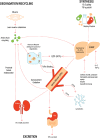Review Article: Albumin and Its Role in Inflammatory Bowel Disease: The Old, the New, and the Future
- PMID: 39894941
- PMCID: PMC11968156
- DOI: 10.1111/jgh.16895
Review Article: Albumin and Its Role in Inflammatory Bowel Disease: The Old, the New, and the Future
Abstract
Background: Circulating albumin concentrations are frequently measured in clinical practice. This review explores biochemical properties and physiological roles of albumin, its place in nutritional assessment, current understanding of perturbed circulating concentrations, and role in clinical management, with special focus on patients with inflammatory bowel disease (IBD).
Methods: A detailed literature search was performed.
Results: Albumin is synthesized by hepatocytes and comprises 3% of total body protein. It has a prolonged intravascular half-life (17-19 h) due to neonatal Fc-receptor-mediated salvage and has a multitude of physiological functions. Albumin homeostasis is affected in disease states often resulting in reduced level, which is not a direct marker of malnutrition. In patients with IBD, morbid albumin concentrations provide prognostic information, identification of nonintestinal conditions, guidance to the required aggressiveness of therapy and biologic dosage, monitoring of disease activity, and potential need for therapeutic escalation. Barriers to utilization of morbid albumin levels include the lack of consensus regarding cutoff values and the deficiency of high-quality data in this domain due to the retrospective design of the majority of studies. Serum levels hold greatest clinical potential in prognostication in acute severe ulcerative colitis. The premorbid level in the individual may provide insight into dosing of biologics and potentially enhance interpretation of morbid levels.
Conclusions: Understanding the physiology and pathophysiology of albumin is fundamental to interpreting its circulating levels. The clinical value of its measurement in patients with IBD may be undervalued, as it assists in evaluation of disease severity, prognosis, and therapeutic decision-making.
Keywords: Crohn's disease; albumin; diagnostic test; hypoalbuminaemia; nutritional assessment; protein turnover; therapeutic drug monitoring; ulcerative colitis.
© 2025 The Author(s). Journal of Gastroenterology and Hepatology published by Journal of Gastroenterology and Hepatology Foundation and John Wiley & Sons Australia, Ltd.
Conflict of interest statement
MW received educational grants or research support from Abbvie and Ferring and speaker fees from Janssen, Abbvie, Takeda, Pfizer, and Celltrion and has served on advisory boards for Abbvie. He holds shares in Atmo Biosciences. MPS received educational grants or research support from Ferring, Orphan, Gilead, and Celltrion and speakers fees from Janssen, Abbvie, Ferring, Takeda, Pfizer, Shire, Celltrion, and Eli‐Lilly and has served on advisory boards for Janssen, Takeda, Pfizer, Celgene, Abbvie, MSD, Emerge Health, Gilead, BMS, Celltrion, and Eli‐Lilly. PRG is a consultant or advisory board member for Anatara, Atmo Biosciences, Topas and Comvita. He has received research grants for investigator‐driven studies from Atmo Biosciences and Mindset Health and speaker honoraria from Dr Falk Pharma and Mindset Health. He holds shares in Atmo Biosciences. The rest of the authors declare no conflicts of interest.
Figures


Similar articles
-
AGA Clinical Practice Update on Diet and Nutritional Therapies in Patients With Inflammatory Bowel Disease: Expert Review.Gastroenterology. 2024 Mar;166(3):521-532. doi: 10.1053/j.gastro.2023.11.303. Epub 2024 Jan 23. Gastroenterology. 2024. PMID: 38276922
-
Evaluation of Albumin, Transferrin and Transthyretin in Inflammatory Bowel Disease Patients as Disease Activity and Nutritional Status Biomarkers.Nutrients. 2023 Aug 7;15(15):3479. doi: 10.3390/nu15153479. Nutrients. 2023. PMID: 37571416 Free PMC article.
-
Hypoalbuminaemia and Postoperative Outcomes in Inflammatory Bowel Disease: the NSQIP Surgical Cohort.J Crohns Colitis. 2019 Oct 28;13(11):1433-1438. doi: 10.1093/ecco-jcc/jjz083. J Crohns Colitis. 2019. PMID: 31253985 Free PMC article.
-
Predictors of Primary Response to Biologic Treatment [Anti-TNF, Vedolizumab, and Ustekinumab] in Patients With Inflammatory Bowel Disease: From Basic Science to Clinical Practice.J Crohns Colitis. 2020 Jun 19;14(5):694-709. doi: 10.1093/ecco-jcc/jjz195. J Crohns Colitis. 2020. PMID: 31777929 Review.
-
Therapeutic Drug Monitoring of Biologics for Patients with Inflammatory Bowel Diseases: How, When, and for Whom?Gut Liver. 2022 Jul 15;16(4):515-524. doi: 10.5009/gnl210262. Epub 2021 Oct 21. Gut Liver. 2022. PMID: 34670875 Free PMC article. Review.
Cited by
-
Decline in Serum Lysophosphatidylcholine Species in Patients with Severe Inflammatory Bowel Disease.J Clin Med. 2025 Aug 4;14(15):5485. doi: 10.3390/jcm14155485. J Clin Med. 2025. PMID: 40807102 Free PMC article.
References
-
- Peters T., “Genetics,” in All About Albumin: Biochemistry, Genetics, and Medical Applications (Elsevier Science, 1995).
-
- Salive M. E., Cornoni‐Huntley J., Phillips C. L., et al., “Serum Albumin in Older Persons: Relationship With Age and Health Status,” Journal of Clinical Epidemiology 45, no. 3 (1992): 213–221. - PubMed
-
- Mendenhall H. W., “Serum Protein Concentrations in Pregnancy. 1. Concentrations in Maternal Serum,” American Journal of Obstetrics and Gynecology 106, no. 3 (1970): 388–399. - PubMed
Publication types
MeSH terms
Substances
Grants and funding
LinkOut - more resources
Full Text Sources

